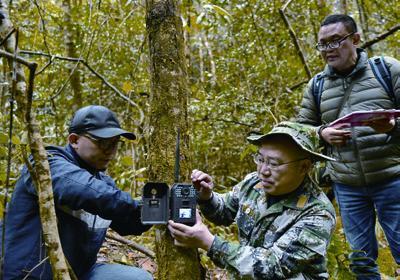Taming Wildlife Trade
By Wang Hairong

From the onset of the pneumonia caused by the novel coronavirus in Wuhan, Hubei Province in central China, in late 2019, people have been trying to unravel a mystery: Where did the virus come from, and how was it fi rst passed to humans?
Although definite answers seem elusive, China has nevertheless taken unequivocally resolute measures to block the transmission of the virus and ensure the safety and health of the public.
Several deadly and contagious diseases relatively new to humans are known to be caused by pathogens originating with wild animals. Recently Chinese researchers unveiled that the natural host of the virus could be bats and its intermediate host possibly pangolins.
Regulatory authorities first issued a document on January 21 to tighten supervision and inspection of physical markets, eateries and e-commerce platforms to crack down on illegal wildlife transactions. On January 26, a nationwide ban on wildlife trading was instituted for the duration of epidemic prevention and control.
Intensified control
After imposing the ban, relevant government organizations convened meetings the first week of February to launch special initiatives on cracking down on illegal wildlife trading in order to halt the spread of the virus from the source, said Yang Hongcan, an offi cial in charge of law enforcement and inspection with the State Administration for Market Regulation, at a press conference on February 8.
Market regulatory departments inspected about 1.5 million business venues from January 21 to February 6, and monitored 491,000 ecommerce platforms and websites, Yang said.
More than 3,700 markets and other business venues were closed down, and 77,000 pieces of online information involving illegal wildlife trading were deleted or shielded, he added, while over 16,000 animal breeding locations were put on quarantine.
Yang mentioned a number of illegal wildlife trading cases that were investigated recently. On January 26, 55 snakes, seven bamboo rats and other animals were seized in Xiushan County in the southwestern municipality of Chongqing. In Changyi District in Jilin City, Jilin Province in the northeast, African spurred tortoises and geckoes, two animals under national protection, were intercepted on January 27. And in Qianjiang City in Hubei, authorities confiscated 343 wild animals on January 30.
According to the Department of Forestry of the southeastern province of Fujian, under a campaign codenamed Spring Action, approximately 1,000 forest police officers patrol key venues to crack down on wildlife-related crimes every day; some 15,000 people, including forest rangers and natural reserve patrols, monitor mountainous and forest areas every day to prevent illegal hunting of wild animals; and about 10,000 law enforcement personnel supervise key business venues such as markets and eateries every day to stop illegal wildlife transactions. The provinces breeding bases have been thoroughly disinfected and are under real-time monitoring.
In addition to rigorously cracking down on illegal trading of wildlife, efforts will be stepped up to block consumers access to animals illegally captured and traded, Yang said.
Legal improvement
In an effort to fi ght the novel coronavirus outbreak, the National Peoples Congress (NPC), Chinas top legislature, is considering amending the law on the protection of wildlife this year, said Wang Ruihe, an offi cial with the Legislative Affairs Commission of the NPC Standing Committee, at a press conference on February 10. Efforts will also be made to accelerate the amendment of laws on animal epidemic prevention and other areas, he said.
Potential public health risks caused by trading and eating wild animals have drawn worldwide concern, giving rise to the need to expand the scope of the law and toughen the crackdown, he said.
As the health risks of wildlife consumption became clearer during the fi ght against severe acute respiratory syndrome (SARS) in 2003, widespread measures were taken to tackle the problem, with Guangdong Province in south China shutting down related markets and enforcing an outright ban. However, in recent years, bushmeat has gradually sneaked back onto some dinner tables.
Both legislation and law enforcement related to wildlife need to be improved, said Liu Peng, a professor at the School of Public Administration and Policy, Beijing-based Renmin University of China.
Wildlife protection is stipulated in the Criminal Law, laws on wildlife protection and animal epidemic prevention, animal quarantine management measures and regulations on the implementation of terrestrial wildlife protection. The Law on the Protection of Wild Animals bans the hunting and killing of wildlife under national protection as well as the trading of the protected species and their products. It also states that the hunting of animals not under state protection requires licensing and is subject to quota management.

However, Liu said these provisions have some common drawbacks. For instance, they focus more on key animals, mostly rare and endangered, but are relatively weak regarding the protection of the common ones.
They tend to be fuzzy in the definition and classification of wild animals, and impose light punishment for illegal trading of those that are not under national protection, he explained. Moreover, the provisions on the trading of artificially bred animals and online wildlife trading are not clear enough.
Currently, issues concerning wild animals not under national protection are handled by local governments. Liu conceded that some officials may not have enough incentive to strictly regulate wildlife trading.
Moreover, as wildlife consumption involves many links along a long chain including hunting, breeding, selling, transporting, slaughtering and cooking, fullcoverage supervision is hard to carry out. While stepping up routine law enforcement, it is essential to encourage industry associations and businesses to exercise self-discipline and consumers to give up bushmeat consumption, Liu said.
The supervision of wildlife trading is not only about protecting ecological resources; but more importantly, it is about protecting public health, he said.
Uncovering missing links
Amid efforts for an early win over the novel coronavirus, researchers have also been busy trying to identify the specific animals responsible for it. Upon receiving a report on the outbreak, the National Institute for Viral Disease Control and Prevention under the Chinese Center for Disease Control and Prevention promptly sent researchers to collect samples from the Huanan Seafood Wholesale Market in Wuhan, where the virus is believed to have originated, to fi nd clues to its causes. The market, the largest of its kind in central China, sold seafood and wild animals such as tiger frogs, snakes and hedgehogs before being shut down on January 1. Several of the earliest infected patients had worked there before being hospitalized.
On January 26, the institute announced that 33 of the 585 environmental samples collected contained novel coronavirus nucleic acids, suggesting that wild animals sold in the market were a source of the virus but researchers could not pinpoint any specific animal as the natural host.
A team led by Shi Zhengli, a researcher with the Wuhan Institute of Virology, published an article on January 23, indicating that bats are the natural host of the virus. The article noted that its genetic sequence is 96.2 percent identical to a bat coronavirus and 79.5 percent identical to the coronavirus that caused SARS in 2003. Their fi nding appeared in the UK-based academic journal Nature on February 3.
Shi and her colleagues have been traveling across the country to study bat viruses for more than a decade. In 2017, her team discovered 15 virus strains with all the genetic building blocks of the SARS virus among horseshoe bats inhabiting a cave in Yunnan Province in southwest China. Their research provided strong evidence that the SARS virus that plagued China 17 years ago originated with bats, and was later passed to humans by civets.
However, since bats hibernate during winter, scientists reckon that there had to be one or more intermediary hosts to pass the virus to humans. Researchers at South China Agricultural University found that the metagenome sequence of a novel coronavirus strain separated from pangolins is 99 percent identical to that from infected people.
Shen Yongyi, a professor at the university and a member of the research team, said there are usually multiple intermediate hosts, and pangolins may just be one of several.

